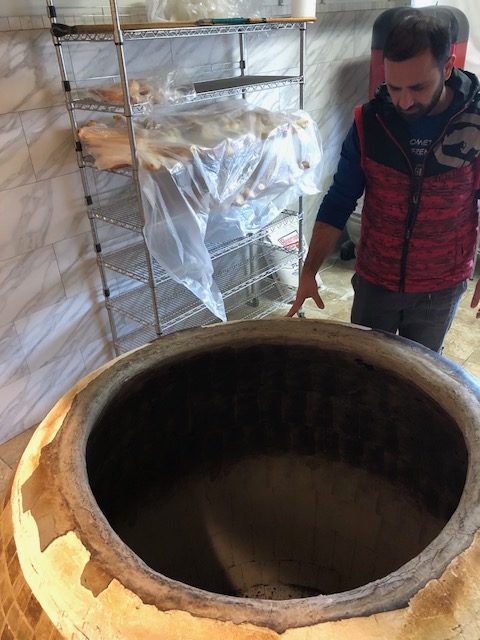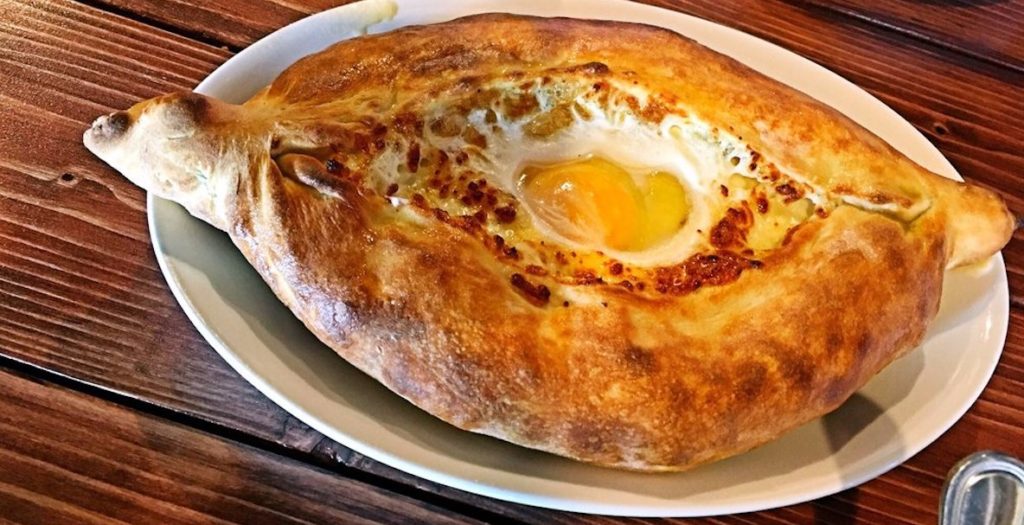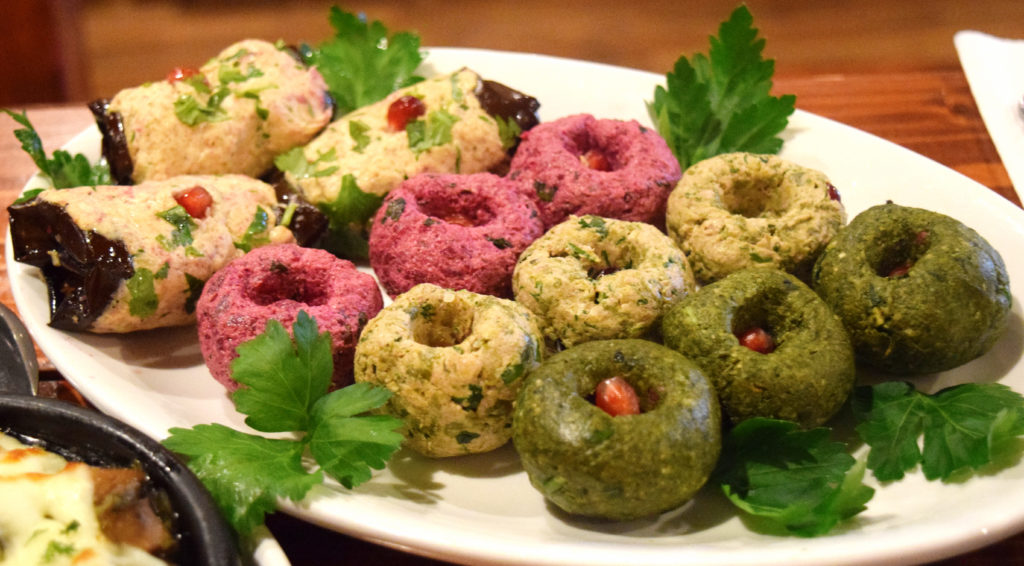Foodizen: Georgian On My Mind
Feb. 14, 2019
Philadelphia is a big city. This is perhaps a cocky-axiomatic, simplistic statement. But Philly is truly bigger than many of us—particularly those of us who spend our lives working and surviving the daily grind in Eye City or Quondam City or East Passyunk or West Philly or Fishtown—tin scarcely imagine and rarely capeesh.
I was thinking about this on a recent evening while I was eating at a Georgian restaurant, called Georgian Bread, tucked away amidst the vape shop, nail salon, and Nuts To You in a well-worn strip mall on Bustleton Artery in Somerton, the farthest of the Far Northeast—at to the lowest degree 45 minutes by automobile from the Denizen's offices in Center City, or well-nigh an hour and a half by public transportation.
![]()
Over the past few weeks, I'd too eaten at 2 other Georgian restaurants in two other strip malls within a mile of this ane—New Georgian House and Georgian Baker & Café. The latter of these sits in Leo Mall, across from NetCost , a grocery store that'southward sort of similar an sometime-school Summit in a parallel dimension, in which almost every item has been replaced past a Russian or other Cyrillic-linguistic communication product, with seemingly endless varieties of pelmeni and pierogies in the frozen alley, separate counters for kielbasa, plov, pickles, smoked fish, and caviar, and transactions mostly happening in Russian. Exterior, y'all tin choice up a half-dozen Russian or Eastern-European local newspapers.
The cheese-filled bread that is Georgia'south national dish is then fundamental to life in that location that Georgian economists rails inflation using a Khachapuri Index.
This Russian-speaking presence, with immigrants from the old Soviet republics, besides as Eastern Europe, is perhaps slightly better known—all you accept to practice is drive down Bustleton Artery to notice all the Cyrillic concern signs. But the estimated 26,000 Russian-speaking residents of Philadelphia alive mostly nether the radar, and mostly in the Northeast—where 30 percent of the 200,000 residents who reside n and west of Roosevelt Boulevard are foreign-born. For years, you could swallow fine Ukrainian and Uzbek, even Moldovan, food—much of it served in flashy banquet-hall-style event spaces , with live entertainment , strobe lights and smoke machines.

Yet y'all could not dine on food from the Democracy of Georgia, a country bordered by Turkey, Armenia, Republic of azerbaijan, and Russia. And then, in 2017, the first of iii Georgian restaurants opened in Somerton, and then two more over the form of 18 months. This actually follows a strange-but-logical arc, because over the by couple years, Georgian cuisine had become oddly popular among hipsters at the avant-garde of food and drinkable trends. Information technology began with Georgian wines, fabricated from obscure grapes like saperavi and rkatsiteli, traditionally aged in huge earthenware amphora called quevri , which became darlings of the natural wine movement. Georgian food followed. ![]()
What is Georgian nutrient? It begins with the breadstuff, and the star attraction is khachapuri , a cheese-filled staff of life that is Georgia'southward national dish (actually protected by UNESCO as "intangible cultural heritage"). It's so central to life there that Georgian economists track inflation using a Khachapuri Index . Khachapuri takes several forms, but the nearly popular here is adjaruli khachapuri, which comes out looking like a boat filled with piping hot cheese, butter, and a fresh-cracked egg, which is then swirled, poached, and mixed together tableside. For those who are not carb-, gluten-, or dairy-balky, khachapuri is simply cheesy-eggy sky.
"It'southward not pizza, though it looks a footling like pizza," says 32-yr-old Imeda Londaridze, the owner of Georgian Bread, which has a baker and take out shop next to the restaurant. In the morning, you can watch Londaridze through the forepart window, baking the well-baked, chewy rough-and-tumble-shaped loaves in a toné, a cone-shaped brick hearth. He sticks them inside the hot wall by mitt, where they bake and crust until he pulls them off with a hook. "Georgians swallow a lot of bread," he says, adding that he sells near 300 to 400 khachapuri in the restaurant during a normal weekend.
Londaridze immigrated to the U.S. with his parents and siblings in 2007. Before he opened Georgian Bread, Londaridze had no restaurant experience. But he saw there was an opportunity to bring Georgian nutrient to the Northeast. Now, he employs a Georgian chef, though his mother and wife are in the kitchen making the khachapuri and khinkali.
But Georgian food ranges well beyond khachapuri. The large soup-dumpling-similar khinkali , filled with herbal broth, beef, and pork—which you lot eat with your hands—are solitary worth a visit. Georgian food is first-class common cold-weather condition condolement nutrient, with stews like chakpuli , with veal and tarragon slow-simmered in a wine goop, or the traditional spicy-beef kharcho , or fifty-fifty a rich slow-cooked mushroom stew covered with melted cheese. The mtsvadi , shish kebab with chicken or lamb, are dramatically served on dagger-like skewers.

As an appetizer, there is a colorful, cold plate of phkhali —spinach, beets, or greenish beans ground into a paste with walnuts and herbs, and topped with pomegranates, that are perfect spreads for the breadstuff. Then there is the foreign "Georgian lemonade" that is non lemonade at all, but sodas flavored pear or tarragon, the latter surprisingly pleasant despite the alarming neon green color. Traveling to the Far Northeast to swallow Georgian food is truly similar traveling to a foreign country without leaving the city.
![]()
"Americans, they know every kind of nutrient. Only Georgian food is very different. Nobody else has exactly this type of nutrient," says Londaridze, who spells out his motto, "Endeavour Something Different," right on the takeout boxes. Still, Russian or Georgian was more often than not what I heard from fellow diners speaking at the other tables. In fact, at all three Georgian restaurants, we were greeted in Russian earlier switching to English. Georgian nutrient is a well-known entity in Russia and Ukraine—sort of like Italian restaurants here—then there was a built-in audience in the Northeast for Georgian cuisine. The prefered BYOB for a number of tables seemed to be good for you pours of Cognac or vodka.
I'thou a fan of all three Georgian restaurants, and each has its specialty. New Georgian Firm has an interesting take on khachapuri with bacon and decadent smoked hocks and Georgian Bakery & Café's space is attractive, with wooden tables and brick walls busy with traditional Georgian costume, and evening entertainment, and it may take the best phkhali. But Georgian Breadstuff is my favorite.
We'll see what happens when the so-called "hipster situation" meets Georgian food sometime this year, as a new proposed Georgian dinner theater volition open up on Frankford Avenue, in an old ice cream factory next to Barcade.
Londaridze immigrated to the U.Southward. with his parents and siblings in 2007, when he was nineteen, first to Brooklyn, and then shortly ending up in Philadelphia. "When we came here, there weren't a lot of Georgians. Just a few families and I knew them all," he said. "Now in that location are a lot more." Before he opened Georgian Bread, Londaridze had no restaurant feel — he ran a trucking company with his blood brother. But he saw there was an opportunity to bring Georgian nutrient to the Northeast. Now, he employs a Georgian chef, though his mother and wife are in the kitchen making the khachapuri and khinkali. His father built all the long wooden tables and benches, and the light wood-paneled walls that sort of expect like the within of a sauna. "If information technology's sheetrock in here, it won't look Georgian," Londaridze says.
![]()
What he's doing here in Philadelphia must exist traditional enough, since he's twice been featured on Georgian television dorsum home. Georgian Bread fifty-fifty caught the attention of the former Georgian president Mikheil Saakashvili—who dined in the restaurant final month. Saakashvili was taken to the restaurant by his son, Eduard, who now lives in Philadelphia and works as a journalist, later on having graduated from Swarthmore College.
"I didn't know about the Georgian customs here when I was in college. I didn't realize there was a fairly big community," says Eduard Saakashvili. He would Google "khachapuri" and discover nothing. Then, suddenly, Georgian Breadstuff opened. "I'm not really a foodie," Saakashvili says. "I just like Georgian food because it reminds me of home."

He finds it amusing that the food of his homeland has suddenly become then popular amid the cognoscenti. "It's sort of a hipster situation," he says. "Suddenly, you come to see it in a whole new light. Of a sudden, it's all around in this new form, with a new set of lenses. They're maxim, 'Georgian cuisine is so Instagrammable.'"
![]()
In fact, we'll run across what happens when the so-called "hipster state of affairs" meets Georgian food one-time this year, as a new proposed Georgian dinner theater volition open in Fishtown on Frankford Avenue, in an former ice cream factory next to Barcade.
In that location's always, of course, the danger of cultural appropriation. Saakashvili is a tad clashing nigh Georgian nutrient becoming a "culinary meme." He mentions a new Georgian-themed eating place in in Williamsburg, Brooklyn called Cheeseboat, for instance, which he and I both agree is kind of a dumb name. "Information technology's a niggling bit grating. Information technology's bizarre to me," he says. "But if information technology'southward becoming more pop, I don't see a downside." One positive outcome of the mainstream appeal, he says, is that chefs back home in Georgia accept proudly embraced their apprehensive, traditional dishes as important contributions to globe cuisine.
Saakashvili, who says he "lives a Center City type of life," also learned a lesson about his adopted urban center by traveling to swallow Georgian food. "I didn't realize that Philadelphia is very large and the Northeast is very far away," he says.
Make the trip anyhow. There'south virtue in being a traveler in your own city. Spend an evening in a place that feels thousands of miles away from the Philadelphia that you know. It'south office of what makes this city great—that there are amazing, surprising local pockets of humanity tucked away everywhere.
Jason Wilson is The Denizen's 2022 Jeremy Nowak Swain, funded by Spring Point Partners, in honor of our belatedly chairman Jeremy Nowak. He is the author of three books, including most recentlyGodforsaken Grapes, series editor ofThe Best American Travel Writing, and writes for the Washington Post, New York Times, New Yorker and many other publications.
Header photo: Tim Toohey 



Source: https://thephiladelphiacitizen.org/foodizen-georgian-on-my-mind/
0 Response to "Foodizen: Georgian On My Mind"
Post a Comment